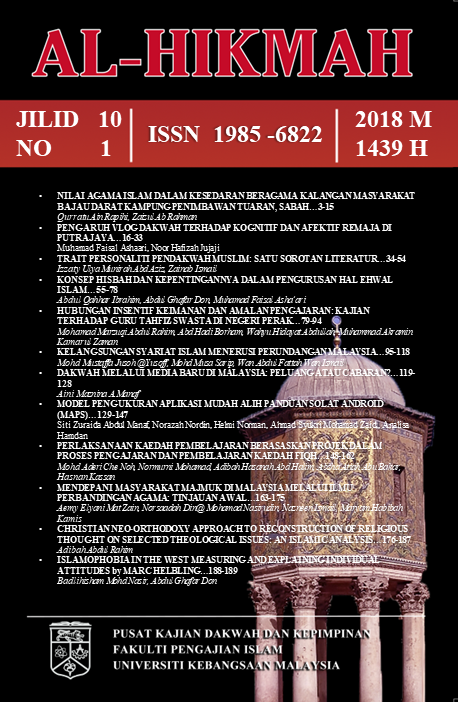MEASUREMENT MODEL FOR PRAYER GUIDE ANDROID MOBILE APPLICATION
Model Pengukuran Aplikasi Mudah Alih Panduan Solat Android (MAPS)
Abstract
This study was conducted to explore the validity of the of the measurement model for the usage of mobile prayer guide application. Additionally, it was also conducted to identify the possible contributions of the prayer guide application to teaching and learning methodologies, user friendly applications, multimedia mobility, and learning outcome. The prayer guide application used for this study was built on Android operating system. Android is a Linux based operating system used for touch screen programs and tablet computers through Google open source. Applications on Android can be downloaded from Google Play. The prayer guide on Android used in this study was built as a guide for the Muslims to perform prayer. This application can be used in the teaching and learning of children and adults on performing prayer. Among the contents of the application are the principles of prayer, ways for ablution, common verses in a prayer, non-obligatory prayers, and the additional prayers. This study was conducted on 70 respondents quantitatively by using MAPS questionnaire which contains 42 items including items on demographic information. The instrument analysis was conducted by using Structural Equation Modeling Partial Least Square 3.2.7. The findings indicated that the content of the Android mobile prayer guide application has positive impact on the teaching and learning method, user friendly application, multimedia mobility, and the learning outcomes. The validity and reliability of the application on the measurement model were also tested in this study. The use of the prayer guide application may create strong learning objectives that will provide a strong platform for those who are looking forward in learning about prayer. This application is helpful especially for those who might be embarrassed to ask and learn the basic skills or before meeting any teachers to learn more about prayer.
References
Al-Quran al-Karim
ALEXA. (2015). http://www.alexa.com/topsites/countries/MY.
Barclay, D., Higgins, C., & Thompson, R. (1995). The partial least squares (PLS) approach to causal modeling: Personal computer adoption and use as an illustration. Technology studies, 2(2), 285-309.
Chin, W. W. (1998). The partial least squares approach to structural equation modeling. Modern methods for business research, 295(2), 295-336.
Fornell, C., & Larcker, D. F. (1981). Structural equation models with unobservable variables and measurement error: Algebra and statistics. Journal of marketing research, 382-388.
Gholami, R., Sulaiman, A. B., Ramayah, T., & Molla, A. (2013). Senior managers’ perception on green information systems (IS) adoption and environmental performance: Results from a field survey. Information & Management, 50(7), 431-438.
Hair, J. F. (2010). Multivariate data analysis.
Hair, J. F., Black, W. C., Babin, B. J., Anderson, R. E., & Tatham, R. L. (2006). Multivariate data analysis (Vol. 6): Pearson Prentice Hall Upper Saddle River, NJ.
Hair, J. F., Ringle, C. M., & Sarstedt, M. (2011). PLS-SEM: Indeed a silver bullet. The Journal of Marketing Theory and Practice, 19(2), 139-152.
Hair Jr, J. F., Hult, G. T. M., Ringle, C., & Sarstedt, M. (2014). A primer on partial least squares structural equation modeling (PLS-SEM): SAGE Publications, Incorporated.
Henseler, J., Ringle, C. M., & Sarstedt, M. (2015). A new criterion for assessing discriminant validity in variance-based structural equation modeling. Journal of the academy of marketing science, 1-21.
Podsakoff, P. M., MacKenzie, S. B., Lee, J.-Y., & Podsakoff, N. P. (2003). Common method biases in behavioral research: a critical review of the literature and recommended remedies. Journal of applied psychology, 88(5), 879.
Santhanamery, T., & Ramayah, T. (2014). Explaining the e-Government Usage Using Expectation Confirmation Model: The Case of Electronic Tax Filing in Malaysia Government e-Strategic Planning and Management (pp. 287-304): Springer.
Sekaran, & Bougie. (2010). Research methods for business: A skill building approach. Wiley: London.
Sekaran, U. (2006). Research methods for business: A skill building approach: John Wiley & Sons.
Shihab, E., Kamei, Y., & Bhattacharya, P. (2012). Mining challenge 2012: The android platform. Paper presented at the Proceedings of the 9th IEEE Working Conference on Mining Software Repositories.
SKMM. (2012). Hand Phone User Survey. Suruhanjaya Komunikasi dan Multimedia Malaysia.
Trochim, W. M. (2005). Research methods: The concise knowledge base: Atomic Dog Publishing.
Copyright (c) 2018 Al-Hikmah

This work is licensed under a Creative Commons Attribution-NonCommercial-NoDerivatives 4.0 International License.
Authors retain copyright and grant the journal right of first publication with the work simultaneously licensed under a Creative Commons Attribution License (CC BY-SA 4.0) that allows others to share the work with an acknowledgement of the work's authorship and initial publication in this journal.








